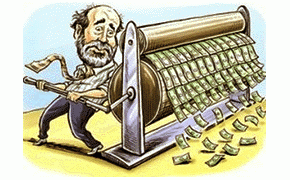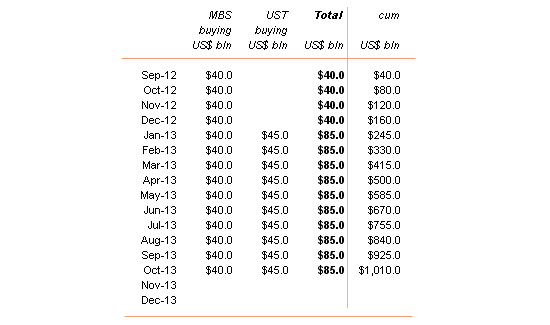
The US Federal Reserve has now bought more than US$1 trillion of bonds as part of its current program of 'financial crisis support' - or open-ended quantitative easing.
Starting in September 2012, the part of the Fed system that carries out these activities, the Federal Open Market Committee (FOMC) decided to increase policy accommodation by purchasing agency-guaranteed mortgage-backed securities (MBS) at a pace of US$40 billion per month "in order to support a stronger economic recovery and to help ensure that inflation, over time, is at the rate most consistent with its dual mandate".
In addition, starting in January 2013, the Federal Reserve began purchasing longer-term Treasury securities at a pace of $45 billion per month.
According to our calculations (below), that means that they have now pumped more than US$1 trillion of 'free money' into their banking system.
There is no end in sight.
Fed officials have signalled they would taper these programs back when they were sure that unemployment was going to be 6.5% or below, but today's NFP report shows that is still a long way off.
Bond buying is the third major step in the Fed's fight agains the GFC.
It started be reducing its target Federal Funds rate from 5.25% to effectively zero in August 2007.
Then it juiced up liquidity in an emergency response as the crisis deepened by lending aggressively at its traditional 'discount windows' in its TAF, PDCF and TSLF programs. Essentially, these programs loosened the criteria for commercial instruments for which the Fed would lend against, and was aimed only at banks.
It followed up these moves with huge bilateral currency swap agreements with 14 other central banks.
Then, in a second tilt at the problem, it pumped liquidity directly to key borrowers (banks) and investors (insurers and other big money market players) in key US credit markets, in programs known as CPFF, AMLF, MMIFF and the TALF. The TALF involved new credit support of US$200 billion.
Now the on-going bond buying 'third leg' has pushed on up through the US$1 trillion level this month.

5 Comments
So, if companies start hiring more people and thus reduce unemployment, they stand to lose free money injections from the Fed.
What seems to be happening is a lot of companies are making record profits and sitting on huge piles of cash but are not hiring. Who would have guessed!
It's easy to see what a profound effect US QE is having on our monetary policy, exchange rate and economy when considering the Fed is printing close to our GDP every couple of months.
If Saudi Arabia decides to stop selling oil in dollars(the petro dollar) will this reduce the world's demand for dollars? If the world decides that the US dollar is turning into funny money from too much QE and they have alternatives, American QE could turn into America's problem and not the rest of the worlds.
DOHA - Saudi Arabia's intelligence chief has said the kingdom will make a "major shift" in relations with the United States in protest at its perceived inaction over the Syria war and its overtures to Iran, a source close to Saudi policy said on Tuesday.
...
But he suggested that the planned change in ties between the energy superpower and its traditional US ally would have wide-ranging consequences, including on arms purchases and oil sales.
Saudi Arabia, the world's biggest oil exporter, ploughs much of its earnings back into US assets. Most of the Saudi central bank's net foreign assets of $690 billion are thought to be denominated in dollars, much of them in US Treasury bonds.
"All options are on the table now, and for sure there will be some impact," the Saudi source said.
Y'also has to figger in the effects of the Affordable Care Act, which of course is anything but:
•Needs young, healthy suckaz to enroll in their millions (7 or so) to pay for the redistribution to the hordes of older, sicker and poorer folks who have now gained entitlements
•Which enrolment effort is being foobarred by a total online enrolment cluster-f**k, long since predicted by those in the know, soon to be a classic MBA case study, and which of course is being denied by all the usual suspects.
•ACA has led directly to a massive drop-off on full-time jobs, and a not-quite corresponding increase in less-than-30-hour-per-week jobs, so as to come under employer responsibility threshholds. With perfectly predictable effects on measured employment rates.
•Which employment effects feed directly into the 6.5% Fed threshhold for QE tapering.
I don't trust their unemployment figures. Is it true that their unemployment payments only last a year or so and after that the unemployed person stops being counted because the Govt isn't paying them anymore?
I think the big problem with Amerian Health Care is that costs are too high. If they could make the system more competitive and drastically lower costs then I think universal health care would be affordable. If the health companies are paying congress though these sorts of reforms are probably impossible to get through.
Basically they have too much cost price inflation in healthcare.

We welcome your comments below. If you are not already registered, please register to comment
Remember we welcome robust, respectful and insightful debate. We don't welcome abusive or defamatory comments and will de-register those repeatedly making such comments. Our current comment policy is here.